Table Of Contents
Are you tired of your dull and boring bedroom? Do you want to transform it into a cozy and stylish retreat? Then look no further, because this article on "Best Bedroom Wallpaper" is here to guide you. Discover the importance of wallpaper in revamping your bedroom and get ready to be inspired with our top picks. Get ready to take your bedroom to the next level.
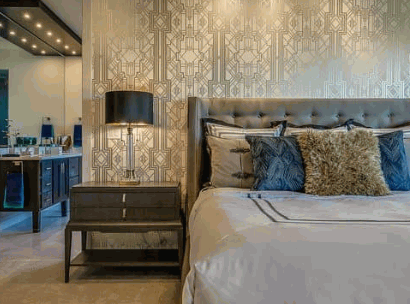
What Is Bedroom Wallpaper?
Bedroom wallpaper is a decorative wall covering that is used to enhance the aesthetic appeal of a bedroom. It is available in a variety of designs, patterns, and colors, allowing individuals to personalize their sleeping space. This type of wallpaper can serve as a focal point in the room or create a soothing backdrop. It is typically made from durable and easy-to-clean materials such as vinyl or fabric. When selecting bedroom wallpaper, it is important to consider the overall theme and style of the room, as well as personal preferences.
Wallpaper has been utilized for centuries to adorn walls. Its popularity grew in Europe during the 16th century and was originally crafted from hand-painted or block-printed paper. In the 19th century, machine-made wallpaper became more affordable and accessible. Today, there is a wide range of bedroom wallpaper options available, thanks to advancements in printing technology that allow for intricate designs and realistic patterns.
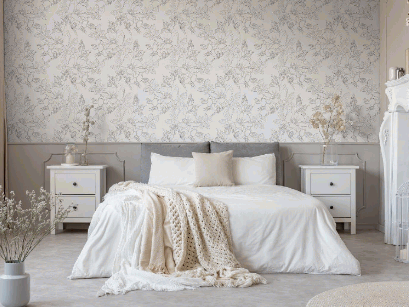
What Are The Types Of Bedroom Wallpaper?
When it comes to decorating your bedroom, choosing the right wallpaper can make all the difference. But with so many options available, it can be overwhelming to decide which type of wallpaper is best suited for your space. In this section, we will explore the various types of bedroom wallpaper, including traditional, vinyl, non-woven, grasscloth, textured, and peel-and-stick. Each type offers unique characteristics and benefits, and by the end, you'll have a better understanding of which type will work best for your bedroom.
1. Traditional Wallpaper
Traditional wallpaper has been a popular choice for bedroom decor for centuries. Here are the steps involved in installing traditional wallpaper:
- Prepare the wall by cleaning and smoothing it to ensure a smooth surface.
- Measure the wall and cut the traditional wallpaper accordingly, leaving a few extra inches at the top and bottom for adjustments.
- Apply wallpaper adhesive to the back of the traditional wallpaper using a roller or brush.
- Hang the traditional wallpaper carefully, starting from the top and working your way down. Smooth out any air bubbles or wrinkles as you go.
- Trim the excess traditional wallpaper at the top and bottom using a sharp utility knife.
- Repeat the process for additional strips of traditional wallpaper, ensuring proper alignment of patterns if necessary.
Remember to follow the manufacturer's instructions for specific types of traditional wallpaper, and seek professional help if needed.
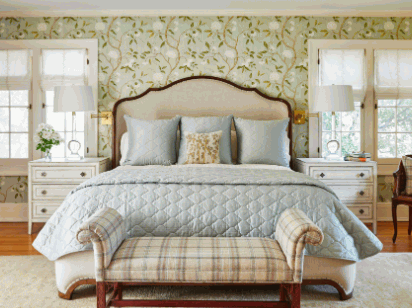
2. Vinyl Wallpaper
Vinyl wallpaper is a top choice for bedrooms due to its durability and versatility. Made from a synthetic material called polyvinyl chloride (PVC), it is resistant to moisture and easy to clean. Homeowners can choose from a wide range of colors, patterns, and textures, making it a popular option. It is also simple to install and remove, making it convenient for those who like to change their decor often.
Popular vinyl wallpaper designs include:
- floral
- geometric
- damask patterns
Consider using vinyl wallpaper for a stylish and low-maintenance bedroom makeover.
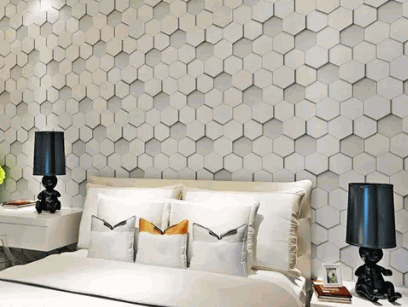
3. Non-woven Wallpaper
Non-woven wallpaper is a popular type of wallpaper for bedrooms, known for its durability and ease of installation. It is created using a combination of synthetic and natural fibers, resulting in a strong and tear-resistant material. This type of wallpaper is also breathable and resistant to mold and mildew, making it ideal for use in high-humidity areas. Additionally, it is easy to clean and can be removed without leaving any residue behind.
With a wide variety of colors, patterns, and textures to choose from, non-woven wallpaper offers versatility in design options. Consider using non-woven wallpaper for a hassle-free and long-lasting option for your bedroom walls.
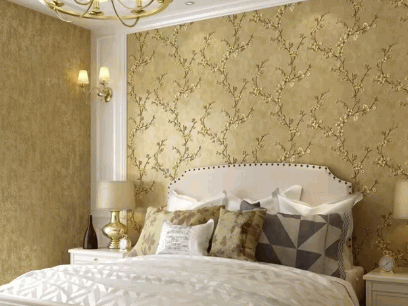
4. Grasscloth Wallpaper
Grasscloth wallpaper is a type of bedroom wallpaper made from natural fibers, such as jute, hemp, or seagrass. It adds texture and a touch of nature to any room. This unique wallpaper is known for its irregular patterns, offering a rustic and organic look. Not only is it durable and able to withstand wear and tear, but it also has a long history. Originating in Asia, grasscloth wallpaper has been used for centuries and was traditionally handwoven using natural plant fibers. However, due to its sensitivity to moisture, it is not recommended for use in high-humidity areas like bathrooms. This type of wallpaper is commonly found in bedrooms, living rooms, and dining areas, creating a cozy and natural ambiance.
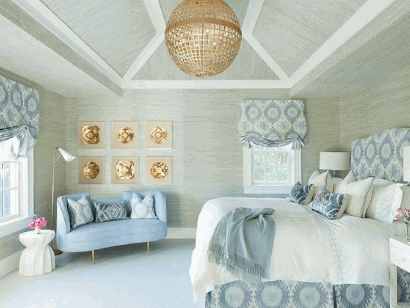
5. Textured Wallpaper
Textured wallpaper adds dimension and visual interest to a bedroom. Follow these steps to successfully install textured wallpaper:
- Begin by preparing the wall, ensuring it is clean and free of damage, and any existing wallpaper has been removed.
- Measure and cut the wallpaper to fit the wall, leaving a few extra inches for adjustments.
- Using a roller or brush, apply wallpaper adhesive to the back of the wallpaper.
- Gently hang the wallpaper on the wall, starting from the top and smoothing it down with a wallpaper brush or squeegee.
- Smooth out any air bubbles or wrinkles using a smoothing tool.
- Trim off any excess wallpaper using a sharp utility knife or scissors.
- Continue this process for additional strips, making sure to align the patterns as needed.

6. Peel And Stick Wallpaper
Peel-and-stick wallpaper is a convenient and easy-to-use option for decorating your bedroom walls. Here are the steps for installing this type of wallpaper:
- Clean and prepare the wall surface by removing any dirt or debris.
- Measure and cut the wallpaper according to your wall dimensions, leaving some extra for trimming.
- Peel off a small section of the backing paper to expose the adhesive side of the wallpaper.
- Start at one corner of the wall and slowly stick the wallpaper onto the surface, smoothing it as you go.
- Continue peeling off the backing paper and sticking the wallpaper, ensuring a smooth and even application.
- Use a wallpaper smoother or a squeegee to remove any air bubbles and ensure proper adhesion.
- Trim any excess wallpaper using a sharp utility knife or scissors.
- Repeat the process for additional strips, aligning the pattern if necessary.
Peel-and-stick wallpaper offers a hassle-free way to update your bedroom decor without the need for glue or professional installation.
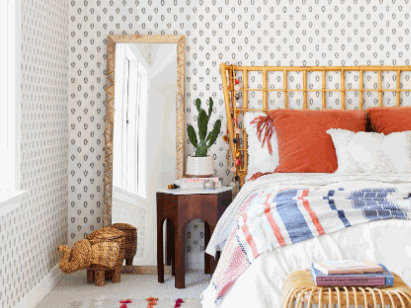
What Are The Factors To Consider When Choosing Bedroom Wallpaper?
When it comes to choosing the perfect wallpaper for your bedroom, there are several factors to consider. The color and pattern of the wallpaper can greatly impact the overall feel of the room, while the material and durability will determine its longevity. It's also important to think about the ease of installation and removal, as well as the cost. Additionally, the size of your room and the amount of natural lighting should be taken into account. Let's delve into each of these factors further to help you make the best decision for your bedroom wallpaper.
1. Color And Pattern
When selecting bedroom wallpaper, it is important to consider both color and pattern to achieve the desired atmosphere and aesthetic.
- Color: Choose a color scheme that complements the existing decor of the room and creates the desired mood. For instance, cool colors like blue and green promote relaxation, while warm colors like red and yellow bring energy to the space.
- Pattern: Take into account the size of the room and the desired visual effect. Large patterns can make a room feel smaller, while small patterns can add depth and texture. Additionally, choose patterns that reflect your personal style and preferences.
Pro-tip: If you are uncertain about committing to a bold color or pattern, try starting with an accent wall before covering the entire room.
Learn more: Blue And Grey Bedroom
2. Material And Durability
When selecting bedroom wallpaper, it is crucial to take into account the material and durability of the wallpaper. Here are some important factors to keep in mind:
- Material: Different materials have unique properties. Vinyl wallpaper is renowned for its durability and resistance to moisture. Non-woven wallpaper is easy to install and remove. Grasscloth wallpaper provides a natural and textured look.
- Durability: It is important to consider the amount of wear and tear the wallpaper will experience. Vinyl wallpaper is highly durable and can withstand heavy traffic areas. Non-woven wallpaper is also durable and can resist fading and staining.
To ensure long-lasting results, choose a material that meets your specific needs and take into consideration factors such as humidity and exposure to sunlight.
3. Ease Of Installation And Removal
When selecting bedroom wallpaper, it's crucial to consider the ease of installation and removal. Follow these steps for a smooth process:
- Prepare the wall by cleaning and repairing any imperfections.
- Measure and cut the wallpaper to fit the wall dimensions.
- Apply adhesive to the back of the wallpaper or directly to the wall.
- Hang the wallpaper, starting from the top and smoothing it out as you go.
- Smooth out any air bubbles and trim excess wallpaper using a wallpaper smoother or straight edge.
- Repeat the process for additional strips, making sure to align the patterns if necessary.
Fun Fact: Many modern wallpapers are designed to be easily removable without causing damage to the walls, making it simple to update your bedroom decor whenever you please.
4. Cost
When considering bedroom wallpaper, it is important to factor in the cost. Here are some key elements to keep in mind:
- Quality: Higher-quality wallpapers tend to have a longer lifespan, but may come at a higher initial cost.
- Material: The material of the wallpaper can impact its price. Vinyl wallpapers are typically more budget-friendly, while grasscloth and textured wallpapers may be more expensive.
- Installation: Professional installation can add to the overall cost, so consider if you are able to install the wallpaper yourself or if you will need to hire someone.
- Quantity: The amount of wallpaper needed to cover the entire room will affect the cost. Be sure to accurately measure the dimensions of the walls to determine the necessary quantity.
- Pattern: Elaborate patterns or designs may require more expensive wallpaper, while simpler patterns may be more affordable.
It is important to establish a budget before beginning your search for bedroom wallpaper and prioritize your preferences accordingly. It can also be beneficial to compare prices and explore different options to find the perfect balance of cost and quality.
5. Room Size And Lighting
When selecting bedroom wallpaper, it is important to take into account the size of the room and the lighting in order to achieve the desired aesthetic and ambiance. Here are some key factors to consider:
- Room size: For smaller rooms, opt for light-colored wallpapers with small patterns, as they can create the illusion of more space. For larger rooms, darker wallpapers with larger patterns can add a sense of coziness.
- Lighting: Be sure to consider both natural and artificial lighting in the room. If the room lacks natural light, choose wallpapers with lighter shades and reflective finishes to help brighten the space. Alternatively, for well-lit rooms, you can opt for bolder and darker wallpaper designs.
What Are The Best Bedroom Wallpaper Designs?
Choosing the perfect wallpaper for your bedroom can be a daunting task, with countless designs and patterns to choose from. To help narrow down your options, let’s take a closer look at the top five best bedroom wallpaper designs. From the classic elegance of floral wallpaper to the modern boldness of geometric patterns, we’ll discuss the unique features and benefits of each design. Whether you’re looking for a calming oasis or a statement piece for your bedroom, there’s a wallpaper design that will suit your style and enhance your space.
1. Floral Wallpaper
Floral wallpaper can add a touch of elegance and beauty to any bedroom. Follow these steps to easily install floral wallpaper in your bedroom:
- Prepare the wall by cleaning and smoothing it.
- Measure and cut the wallpaper according to the wall dimensions.
- Apply adhesive to the back of the wallpaper and carefully hang it on the wall.
- Smooth out any air bubbles using a wallpaper smoother.
- Trim off any excess wallpaper using a sharp knife or scissors.
- Repeat the process for additional strips until the entire wall is covered.
To maintain your floral wallpaper, it is important to avoid excessive moisture, gently clean it with non-abrasive methods, and promptly repair any tears or damages. It is also recommended to keep it away from direct sunlight to prevent color fading over time. With proper care, your floral wallpaper will continue to enhance your bedroom for many years to come.
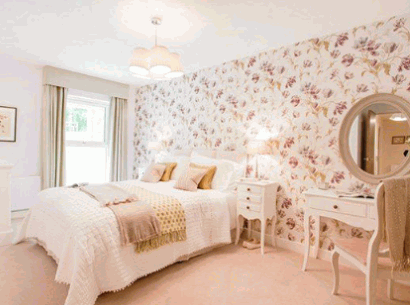
2. Geometric Wallpaper
Geometric wallpaper is a popular choice for adding a modern and stylish touch to a bedroom. It comes in a variety of patterns, including stripes, chevrons, and geometric shapes. When selecting geometric wallpaper, it is important to consider the following factors:
- Color and pattern: Choose a design and color scheme that complements the existing decor of the bedroom.
- Material and durability: Opt for a high-quality wallpaper that is both durable and easy to clean.
- Ease of installation and removal: Look for wallpaper that is simple to install and remove without causing damage to the walls.
- Cost: Keep your budget in mind and find a geometric wallpaper that offers the best value for your money.
- Room size and lighting: Take into account the size of the room and the amount of natural light it receives.
For the most impressive bedroom wallpaper designs, consider geometric wallpapers with bold patterns and contrasting colors. These designs can create a visually striking focal point in the room.
To install geometric wallpaper, gather all necessary materials, measure and cut the wallpaper, apply adhesive, hang the wallpaper, smooth out any air bubbles, and trim excess wallpaper.
To maintain bedroom wallpaper, avoid excessive moisture, clean with gentle methods, and promptly repair any tears or damages. Additionally, avoid direct sunlight to prevent fading.
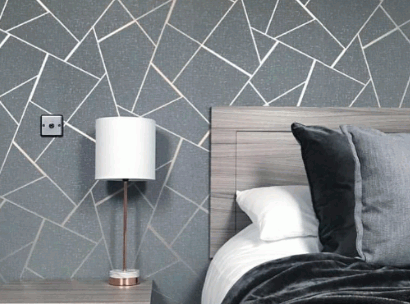
3. Damask Wallpaper
Damask wallpaper is a popular choice for bedroom decor due to its elegant and timeless design. Here is a list of steps to consider when using damask wallpaper for your bedroom:
- Prepare the wall: Clean the wall surface and ensure it is smooth and free from any imperfections.
- Measure and cut the damask wallpaper: Measure the height and width of the wall, adding a few inches for trimming. Cut the wallpaper accordingly.
- Apply adhesive and hang the damask wallpaper: Apply wallpaper adhesive to the back of the wallpaper using a brush or roller. Carefully position the wallpaper on the wall and smooth it out with a wallpaper brush or a clean cloth.
- Smooth out air bubbles and trim excess wallpaper: Use a wallpaper smoother to eliminate any air bubbles and ensure a smooth surface. Trim off the excess wallpaper with a sharp knife or scissors.
- Repeat for additional strips: If your wall requires multiple strips of damask wallpaper, repeat the process for each strip, carefully aligning the pattern.
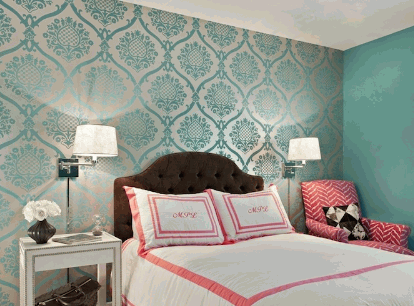
4. Striped Wallpaper
Striped wallpaper is a favored option for bedrooms as it brings visual appeal and can give the impression of height or width in a room. It comes in a variety of colors, widths, and orientations, making it customizable to fit different design styles. Striped wallpaper can make a bold statement or add subtle texture to a space. It complements both modern and traditional decor.
Fun fact: Did you know that striped wallpaper was initially popularized in the 18th century and has remained a timeless design choice ever since?

5. Tropical Wallpaper
Tropical wallpaper can add a vibrant and exotic touch to your bedroom. To incorporate this design into your space, follow these steps:
- Choose the right design: Look for tropical patterns such as palm leaves, flowers, or beach scenery.
- Prepare the wall: Ensure the wall surface is clean and smooth before installation.
- Measure and cut: Measure the height and width of the wall, and cut the wallpaper accordingly.
- Apply adhesive: Follow the manufacturer's instructions to apply adhesive to the back of the wallpaper.
- Hang the wallpaper: Carefully align the first strip with the top of the wall and smooth it down.
- Smooth out air bubbles: Use a wallpaper smoother to remove any air bubbles or wrinkles.
- Trim excess wallpaper: Use a sharp knife to trim any excess wallpaper from the edges.
- Repeat for additional strips: Continue hanging and aligning strips until the entire wall is covered.
To maintain your tropical wallpaper, avoid excessive moisture, clean with gentle methods, and repair any tears or damages immediately. Enjoy the tropical paradise in your bedroom!
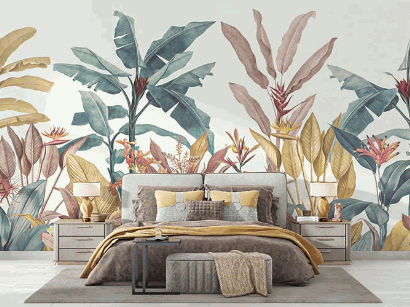
How To Install Bedroom Wallpaper?
Are you looking to give your bedroom a fresh new look? Wallpaper can be a great way to add color and texture to your walls. But how do you install it properly? In this section, we will discuss the step-by-step process of installing bedroom wallpaper. From gathering materials and preparing the wall to smoothing out air bubbles and trimming excess wallpaper, we’ll cover all the necessary steps to achieve a flawless wallpaper installation. So let’s get started!
1. Gather Materials And Prepare The Wall
Before installing bedroom wallpaper, it's important to gather materials and prepare the wall properly. Here are the steps to follow:
- Clean the wall surface by removing any dirt, dust, or grease.
- Repair any cracks or holes in the wall with a spackling compound.
- Sand down any rough areas to create a smooth surface.
- Apply a primer to the wall to ensure better adhesion of the wallpaper.
- Measure the wall and cut the wallpaper accordingly, leaving a few inches of excess on each side.
- Apply adhesive to the back of the wallpaper using a paint roller or brush.
- Carefully hang the first strip of wallpaper, making sure it aligns properly.
- Smooth out any air bubbles or wrinkles using a wallpaper smoother or a clean, damp cloth.
- Trim off the excess wallpaper using a utility knife or scissors.
- Repeat the process for additional strips, making sure to match the pattern if applicable.
Remember to take your time and follow the manufacturer's instructions for the specific wallpaper you're using. Good luck with your wallpaper installation!
2. Measure And Cut The Wallpaper
- Begin by measuring the wall: Use a tape measure to determine the height and width of the wall.
- Add a few extra inches to the measurements: This will account for any mistakes or adjustments during installation.
- Mark the measurements on the back of the wallpaper: Use a pencil to make clear markings.
- Carefully cut the wallpaper: Use a sharp utility knife or wallpaper scissors to precisely cut along the marked measurements.
- Trim any excess edges: This will ensure a clean and precise fit once the wallpaper is installed.
Fun Fact: Taking accurate measurements and cutting the wallpaper properly is crucial for a seamless and professional-looking installation.

3. Apply Adhesive And Hang The Wallpaper
To properly apply adhesive and hang wallpaper in your bedroom, carefully follow these steps:
- Prepare the wall by thoroughly cleaning and smoothing it.
- Measure and cut the wallpaper to fit the dimensions of the wall.
- Using a roller or brush, apply adhesive to the back of the wallpaper.
- Starting from the top, carefully hang the wallpaper, ensuring it aligns with the edges.
- Smooth out any air bubbles using a wallpaper smoother, working from the center towards the edges.
- Trim any excess wallpaper using a sharp utility knife or scissors.
- Repeat these steps for additional strips, making sure to match patterns as needed.
Remember these helpful tips for a successful wallpaper installation:
- Take your time and be patient throughout the process.
- Always follow the specific instructions provided by the manufacturer for your chosen wallpaper.
- If you are unsure or inexperienced with wallpaper installation, it is best to seek professional help.

4. Smooth Out Air Bubbles And Trim Excess Wallpaper
- Smooth out air bubbles: Starting from the center, gently use a wallpaper smoothing tool to push out any air bubbles towards the edges.
- Trim excess wallpaper: Carefully use a sharp utility knife or scissors to trim the excess wallpaper along the edges of the wall or at corners.
- Ensure clean edges: Use a straight edge or ruler as a guide to create clean, straight edges.
- Repeat for all strips: For each strip of wallpaper, repeat the process of smoothing out air bubbles and trimming excess wallpaper.
- Blend seams: Use a seam roller to press down and blend the seams between wallpaper strips, creating a seamless look.
5. Repeat For Additional Strips
When installing bedroom wallpaper, follow these steps to repeat the process for additional strips:
- Gather Materials and Prepare the Wall: Ensure you have all the necessary tools and remove any existing wallpaper or debris from the wall.
- Measure and Cut the Wallpaper: Measure the height of the wall and add a few extra inches for trimming. Cut the wallpaper into strips of the appropriate length.
- Apply Adhesive and Hang the Wallpaper: Apply wallpaper adhesive to the back of the first strip and carefully position it on the wall, smoothing it out as you go.
- Smooth Out Air Bubbles and Trim Excess Wallpaper: Use a wallpaper smoother or a clean cloth to remove any air bubbles and ensure the wallpaper is flat against the wall. Trim any excess wallpaper at the top and bottom.
- Repeat the Process for Additional Strips: Continue the process for each additional strip, aligning the pattern and overlapping the edges slightly for a seamless look.
Wallpaper has been used to decorate interiors for centuries, with evidence of its existence dating back to ancient Egypt. Initially, it was hand-painted and reserved for the wealthy. In the 18th century, advancements in printing technology made wallpaper more accessible. Today, there is a wide range of designs, materials, and techniques available, allowing homeowners to personalize their bedrooms with ease.
What Are Some Tips For Maintaining Bedroom Wallpaper?
As homeowners, we all want our bedroom wallpaper to look as beautiful and pristine as the day it was installed. However, maintaining wallpaper can be a challenging task if not done correctly. In this section, we will discuss some useful tips for keeping your bedroom wallpaper in top condition. From avoiding excessive moisture to repairing damages, these simple yet effective methods will ensure that your wallpaper stays looking fresh and stylish. Let's dive in and learn how to properly care for your bedroom wallpaper.
1. Avoid Excessive Moisture
Excessive moisture can be damaging to bedroom wallpaper, so it is crucial to take precautionary measures to protect it. Here are some steps to follow in order to avoid excessive moisture:
- Ensure proper ventilation in the room by opening windows or using a dehumidifier.
- Avoid placing wallpaper near areas that are prone to moisture, such as bathrooms or kitchens.
- Seal any cracks or gaps in the walls to prevent moisture from seeping in.
- Consider using waterproof wallpaper or applying a protective coating to add an extra layer of defense.
- Clean up any spills or leaks immediately to prevent water damage to the wallpaper.
2. Clean With Gentle Methods
To keep your bedroom wallpaper clean and well-maintained, follow these gentle methods:
- Dust Removal: Use a soft, dry cloth or feather duster to gently remove surface dust.
- Spot Cleaning: Dampen a clean cloth slightly with water or a mild detergent solution. Gently dab the stained area, being careful not to scrub or rub vigorously.
- Stain Treatment: For stubborn stains, mix a gentle cleaner with water and apply it to a clean cloth. Blot the stain gently, then rinse the area with a damp cloth.
- Drying: After cleaning, allow the wallpaper to air dry. Avoid using excessive heat or direct sunlight, as they can damage the wallpaper.
By following these gentle methods, you can effectively clean your bedroom wallpaper without causing any damage.
3. Repair Tears Or Damages Immediately
Repairing tears or damages in bedroom wallpaper is crucial to maintain its aesthetic appeal. Follow these steps to promptly address such issues:
- Assess the damage: Identify the extent of the tear or damage to determine the necessary repair method.
- Prepare the area: Clean the damaged area, removing any loose wallpaper or debris.
- Apply adhesive: Use wallpaper adhesive to secure the torn edges or reattach loose sections.
- Smooth out air bubbles: Gently flatten the repaired area with a wallpaper smoother to ensure a seamless finish.
- Blend the repair: If needed, use touch-up paint or a similar pattern to camouflage the repaired area.
Pro-tip: Keep spare wallpaper for each room to ensure a seamless repair in case of future damages.
4. Avoid Direct Sunlight
To protect your bedroom wallpaper from damage, it is important to avoid direct sunlight. Here are some steps you can take to prevent sunlight-related issues:
- Position furniture strategically to block sunlight from directly hitting the wallpaper.
- Install window treatments such as curtains or blinds to control the amount of sunlight entering the room.
- Consider using window film or UV-blocking window treatments to reduce the intensity of sunlight.
- Avoid placing valuable or delicate items near windows, as they can be damaged by prolonged exposure to sunlight.
- Regularly monitor the condition of the wallpaper and look for signs of fading, discoloration, or peeling caused by sunlight.
By following these steps, you can protect your bedroom wallpaper and ensure its longevity and visual appeal.


